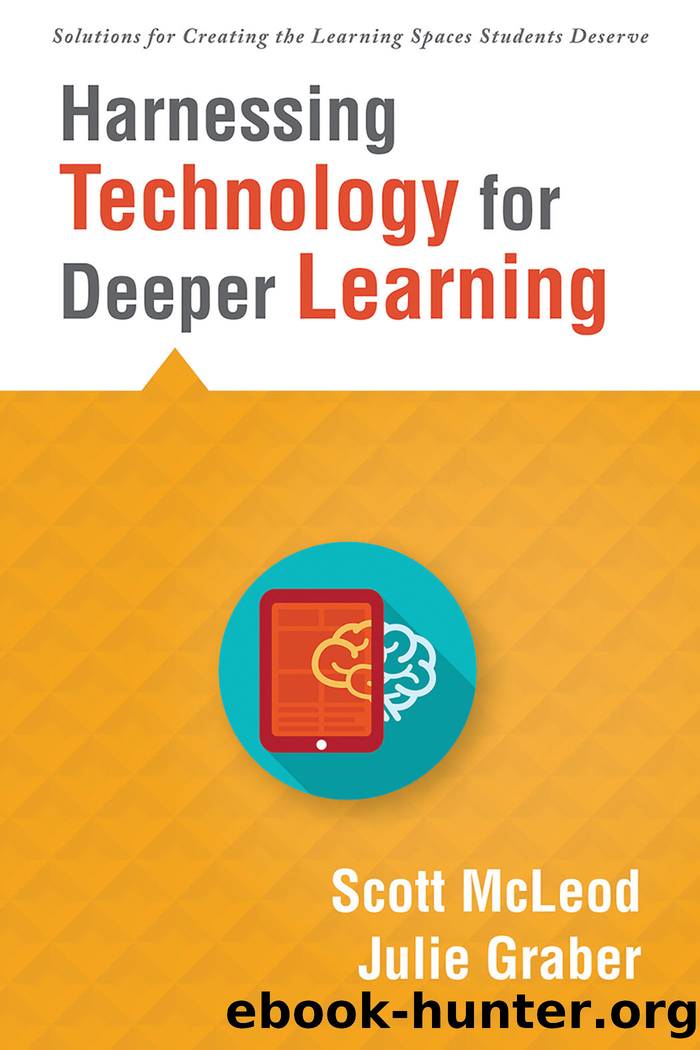Harnessing Technology for Deeper Learning by Scott McLeod

Author:Scott McLeod
Language: eng
Format: epub
Publisher: Solution Tree Press
Published: 2018-01-15T00:00:00+00:00
Middle School Health
For our fifth example of lesson or unit redesign, letâs look at a middle school health lesson. One traditional lesson is to ask students to imagine that they are food traveling through the digestive system. Some teachers use a Food Postcards activity to conduct this lesson.
Food Postcards
In this lesson, teachers give students the task of creating a series of postcards to describe a trip through the digestive system. More specifically, students select a particular food and then create five postcards that they compose from that food itemâs point of view. On one side of each postcard, students draw a picture of something the food might âseeâ on its journey. On the other side of each postcard, students write a description of the events the food experiences. For example, suppose the food a student chooses is an apple. The postcard describing the mouth might have a picture of teeth on the front. The message on the back might begin, âDear Mac, so far I have had a miserable trip. I havenât even left the mouth yet, and already the teeth that you see on the other side of this postcard have torn me apart, crushed me, and cut me into pieces.â
For this lesson, teachers expect students to include the structures and functions of the digestive system that they describe and define any health terms that they use in their descriptions. Studentsâ first postcards feature the mouth, and students should mention the role of the teeth in mechanical digestion and the role of saliva in chemical digestion. Studentsâ second postcards relate to the foodâs journey through the esophagus. Students should describe how the body keeps food from entering the windpipe and how mucus and peristalsis help to move the food through the esophagus. The third postcards cover the stomach and should describe both mechanical digestion by the contraction of muscles and chemical digestion by digestive juices. The fourth postcards feature the small intestine. For these cards, students should describe the chemical digestion that occurs as a result of the enzymes and secretions of the small intestine, liver, and pancreas. They also should discuss how nutrients are absorbed through villi. The final postcards come from the large intestine. Students should mention the bacteria that feed on the material passing through the large intestine. They also should note that water is absorbed into the bloodstream and that the rest of the material is eliminated. Throughout the postcard creation process, students should try to include as much information about the digestive system on their postcards as they can.
Download
This site does not store any files on its server. We only index and link to content provided by other sites. Please contact the content providers to delete copyright contents if any and email us, we'll remove relevant links or contents immediately.
Figuring Out Fluency in Mathematics Teaching and Learning, Grades K-8 by Jennifer M. Bay-Williams & John J. SanGiovanni(244)
The Principal's Guide to Curriculum Leadership by Sorenson Richard D.;Goldsmith Lloyd M.;Mendez Zulma Y.;Maxwell Karen T.;(171)
Macmillan Primary Grammar 2 Pupil's Book by Unknown(143)
English Grammar Practice--The Noun by Roxana Nastase(139)
Text-Dependent Questions, Grades K-5 by Douglas Fisher & Nancy Frey & Heather Anderson & Marisol Thayre(133)
Learning from Accidents 3rd ed by Trevor Kletz (2001)(128)
Harnessing Technology for Deeper Learning by Scott McLeod(120)
Deep Change Leadership by Reeves Douglas;(117)
English Language Program Administration by Unknown(115)
A Guide to Curriculum Mapping by Hale Janet A.;(110)
The Grammar Teacher's Activity-a-Day by Jack Umstatter(107)
Using Equity Audits to Create Equitable and Excellent Schools by Skrla Linda E.;McKenzie Kathryn B.;Scheurich James Joseph;(101)
Using Data to Close the Achievement Gap by Johnson Ruth S.;(99)
Differentiated Instructional Strategies for the Block Schedule by Gregory Gayle H.;Herndon Lynne E.; & Lynne E. Herndon(98)
The Power of SMART Goals by Conzemius Anne;O'Neill Jan; & Anne Conzemius(97)
Aligning and Balancing the Standards-Based Curriculum by Squires David A.;(96)
How to Do Everything with Google Tools by Unknown(94)
Beyond the RTI Pyramid by Bender William N.;(92)
You've Got to Reach Them to Teach Them by Schreck Mary Kim; & Schreck(90)
